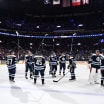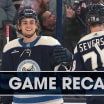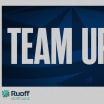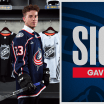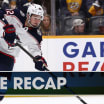Each month during our 20th anniversary celebration, BlueJackets.com will look back at a memorable moment in franchise history from that month with our Game of the Month feature. The series continues today with the team's first-ever playoff win in 2014 against Pittsburgh
In some ways it was the last place Matt Calvert wanted to be, simply because he couldn't be in the one place he truly wanted to be.
On April 27, 2013, Calvert arrived at Nationwide Arena not to play hockey but to watch it. The victim of a freak injury nine days prior -- he blocked a shot with his hand and suffered a broken bone in his index finger, ending his season -- Calvert instead showed up to the Blue Jackets' do-or-die final game of the regular season not to play but to sit and watch.
Game of the Month: First playoff win in Pittsburgh set off a celebration
Calvert's 2OT winner in Game 2 of the 2014 playoffs lives on as a historic victory
"The timing of this could not be worse," he told reporters the day after the injury happened. "This is the time of year when you really want to be playing."
And play he could not. All he could do was join 19,000-plus friends in a raucous Nationwide Arena and, just like them, hope and pray. Not only would the Blue Jackets need a win over visiting Nashville to clinch the second playoff appearance in franchise history, they'd need help elsewhere, the result of a stunning, red-hot run to the finish after a horrible start.
The atmosphere in Nationwide Arena could be cut with a knife, especially as the game went on. The teams skated through a scoreless first period, then Nashville's Shea Weber gave the Predators the lead midway through the second period.
For 20 excruciating minutes, the Preds' 1-0 advantage held -- until the clock ticked under 10 minutes to play. Brandon Dubinsky scored on the power play at the 10:09 mark, then Jack Johnson tallied to give Columbus the lead with 4:48 to go. Sergei Bobrovsky made a crucial save down the stretch, then Cam Atkinson scored into an empty net in the final minute, clinching a 3-1 win that brought with it deafening cheers of delight and relief.
Many of the fans stuck around the arena to watch other games on the big screen, but disappointment reigned. Minnesota's win over Colorado pulled the Wild even with Columbus on points, and the Wild held the tiebreaker. They would be in the playoffs; Columbus, despite a 19-5-3 finish to the season, would not.
But many in the crowd who watched in Nationwide Arena that night, including Calvert, left dreaming of what could come next.
"I was actually sitting in a suite, the players' suite, so I was right in the crowd watching that final game and unfortunately not on the ice performing," Calvert said in a recent interview. "But I certainly got the feel of the crowd. I remember that feeling and, one, the disappointment of not making it (to the playoffs), but two, the excitement of 'This is what we should expect come playoff time,' and we certainly did experience that when we eventually did make it to the playoffs."
One year later, the playoff bid was secured, and Calvert would soon play a huge part in CBJ history. He just couldn't know it at the time.
Establishing a base
From 2011 to 2014, it's hard to imagine a bigger turnaround for a franchise than what happened in Columbus.
The 2011-12 season was nothing short of a disaster, with the Jackets finishing with the worst record in the NHL and stung by the trade for Jeff Carter, an experiment that lasted less than a season before he was dealt to Los Angeles.
Head coach Scott Arniel was fired during the season as well, and the summer of 2012 delivered a series of indignities as well. First, Columbus failed to earn the top overall pick in the NHL draft despite having the worst record, a victim of the ping-pong balls in the draft lottery. Later that offseason, franchise stalwart Rick Nash was traded to the New York Rangers, a deal that at the time rocked the foundation of the club. All of this played out with the specter of a lockout hanging over the sport.
The team wouldn't see the ice until January 2013 because of that lockout, but slowly but surely it became clear Columbus had a competitive team on its hands.
The Nash deal brought in two NHL regulars in Dubinsky and Artem Anisimov who could immediately help the cause. The trade of Carter netted a versatile defenseman in Johnson, while two trades in the summer of 2012 would pay huge dividends, as defenseman Marc Methot was dealt for a young forward named Nick Foligno and the team sent draft picks to Philadelphia for goalie Sergei Bobrovsky.
Add in veterans like Vinny Prospal, Jared Boll, Mark Letestu, Derek MacKenzie, Fedor Tyutin and James Wisniewski and the core of a roster was taking shape. Also developing under the radar was a talented class of youngsters who would start to become key contributors in the form of Calvert, Ryan Johansen, Cam Atkinson and David Savard.
Calvert, Johansen and Atkinson were regulars during that 2013 sprint toward the finish, but the team's 5-12-4 start to the season doomed it to finish just outside of the playoffs.
"We had a pretty good run that year after we figured it out," Calvert says now. "A lot of new faces, and chemistry takes time."
There were high hopes going into the 2013-14 season that the momentum would continue under head coach Todd Richards, and the team was even active in free agency, signing Boston star and Stanley Cup winner Nathan Horton to a seven-year contract.
Things weren't always seamless at the start the campaign, though, in part because of shoulder surgery Horton needed that cost him the first half of the season. Columbus started 2-1, but an ensuing four-game losing streak and then a five-game skid left the team just 5-10-0 through 15 games.
Slowly, things came around, though. Columbus was 16-17-4 by Christmas, then January proved to be a good month, as an eight-game winning streak got the team to 26-20-4. With Bobrovsky starring in net, Johansen becoming an offensive force and a strong work ethic pushing a deep team forward, Columbus wasn't going to be stopped.
Just like the year prior, the Blue Jackets got stronger as the year went on, finishing January with a 10-4-0 record and March with a 9-5-1 mark (the team played just five games in February because of the Olympic break, going 2-2-1).
Johansen's overtime winner in Nationwide Arena on April 8 put the team on the precipice of clinching a playoff berth, and the next night, it happened. A game rescheduled because of the cardiac event suffered by Stars forward Rich Peverley started with Columbus up 1-0, then goals from Anisimov and Mark Letestu and another strong showing by Bobrovsky gave the Jackets a 3-1 win and the second postseason berth in franchise history.
For the players who had come just short the year prior, it was a bit of vindication in the plan. That was especially true for Calvert, who along with linemates Dubinsky and Atkinson would have the important job of trying to shut down such names as Sidney Crosby and Evgeni Malkin.
"I couldn't wait," Calvert said about playing postseason hockey. "I always prided myself on being a playoff guy throughout my whole life, and I could always find another level in my game individually. Being able to play the Pittsburgh Penguins and basically being on the first line was kind of a big deal to me. It was me, Dubinsky and Atkinson, and we were matched up against Crosby's line. I certainly got a much larger role than I had during the season. It was exciting."
History made
Game 1 was held in Pittsburgh on April 16, and two things quickly became clear -- the Blue Jackets would be able to hang with the star-studded Penguins, and it was going to be a wild series.
Johnson scored just over six minutes into the opening game, and Letestu answered a Pens goal later in the period to give Columbus the lead after one. When MacKenzie scored a shorthanded goal in the opening minute of the second period, bars around Columbus were a cacophony of noise.
It didn't last long. Pittsburgh scored a pair of power-play goals in the next two minutes to make it a 3-3 game, then Brandon Sutter's goal eight minutes into the third period proved to be the difference as the Penguins took a 4-3 win.
The mood in the Columbus locker room after 11 of 20 players on the roster made their playoff debuts? Part defiance, part frustration.
"When we got the first goal, the whole bench said, 'We can play with these guys,' " Johansen told reporters. "We gave away the hockey game tonight. We had a comfortable lead and let them back in it. We didn't have the poise with the puck in our own zone and through the neutral zone. We were rushing plays."
That set the stage for Game 2, held on Saturday, April 19, the night before Easter Sunday. And if the Blue Jackets had some divine intervention on their side, it didn't look that way in the early going.
While Columbus had the hot start in the opening game of the series, this time Pittsburgh came out flying. Speedy Pittsburgh forward Brian Gibbons opening the scoring just 3:30 into the game, then he tallied again, this time shorthanded, less than a minute later to stake the Penguins to a 2-0 lead. Johansen got one back with a power-play goal moments later, but Matt Niskanen scored his own power-play goal late in the period to make it 3-1 Pittsburgh after one.
But in a series of momentum swings and special teams goals, Calvert helped turn the tide. With the Blue Jackets on the penalty kill nearing the midway point of the second period, Anisimov poked a puck free to Calvert, who jetted from his own blue line into the offensive zone on a 2-on-1. Rather than pass to Anisimov, Calert let go a shot as he hit the right faceoff dot and beat Marc-Andre Fleury clean to make it a 2-1 game.
"I remember the shorty well," Calvert said. "I went high glove on Marc-Andre Fleury. He's a great goalie, but for whatever reason, high glove always worked on him. That was obviously exciting. That was my first playoff goal."
It wouldn't be his last on the night. But first, there was plenty of hockey to play. Columbus pushed for an equalizer and got it with 6:01 to play on the fifth special teams goal of the game, as Johnson took a cross-crease feed from Johansen and blasted it past Fleury to tie the score at 3.
That led to overtime, and in the first OT, Pittsburgh had two power-play chances and Columbus one, but neither Bobrovsky nor Fleury was beaten. The Jackets' second penalty of the period leaked into the second OT, and when Blake Comeau stepped out of the box, Richards went to his energy line of Calvert, Dubinsky and Atkinson.
History was soon to be made. It was a hard-working goal, with Calvert feeding Dubinsky behind the net then cutting to the back door. Dubinsky fought off Jussi Jokinen and centered a pass to Atkinson, who was all alone between four Penguins at the front of the cage.
Fleury was able to fight off Atkinson's shot, but the rebound went right to the open Calvert at the left post as Kris Letang and Lee Stempniak converged on Atkinson. Calvert's initial swat at the rebound went off the right pad of Fleury thanks to a spectacular save by the Penguins goalie, but Calvert still had enough time to gather a third try and lift it over the pad and into the empty net just 1:10 into the second OT.
Calvert raised his arms in celebration, then skated back toward the middle of the ice. As he tried to celebrate, he was immediately tackled by Atkinson, setting off a dogpile on the ice at Consol Energy Center. For a player who had nine regular-season goals, the two-goal game couldn't have come at a better time, but Calvert had the feeling he'd be in the right place at the right time when OT began.
"In overtime, sometimes guys get nervous," he said. "I remember going out for that second overtime and it was just a feeling of, 'I'm back.' I had that feeling of being back in juniors, whether it was a playoff series, playoff overtime. I remember having a smile on my face skating out for that second overtime and, this was even before I scored, just saying to myself, 'You have these special moments in your career. This is why I play the game of hockey. I have a chance to be a hero.'
"It was probably one of the most amazing moments of my career, for sure."
The win returned the series to Columbus with hope, but the topsy-turvy nature of the series continued. Columbus took a 3-1 lead early in the third period of Game 3 only to see Pittsburgh come back to win it 4-3 in regulation; two nights after that, in Game 4, Columbus rallied from a 3-0 hole to win in overtime after Brandon Dubinsky's late equalizer and Nick Foligno's famous OT goal that nearly blew the roof off of Nationwide.
Pittsburgh took a much simpler 3-1 win in Game 5, but Game 6 in Nationwide Arena was nearly another miracle. The Penguins took a 4-0 lead through 40 minutes, but the Blue Jackets scored three times in the last 10 minutes to make it a game before Pittsburgh closed out a 4-3 win to capture the series four games to two.
Those first two wins in CBJ history are remembered fondly, though, as it was the first time fans truly experienced the back-and-forth emotions of a playoff campaign. Though the Jackets would come up short, the series put the team on the right path, as it kicked off a string of five playoff appearances in seven years, many of them with the same core players.
"You come to a team and then all of a sudden the team starts finding success," Calvert said. "The fans were always so great to us in Columbus as well. It was a lot of fun because I think anytime you come into an organization searching for success and you're a small part of that, it's a real good feeling."



